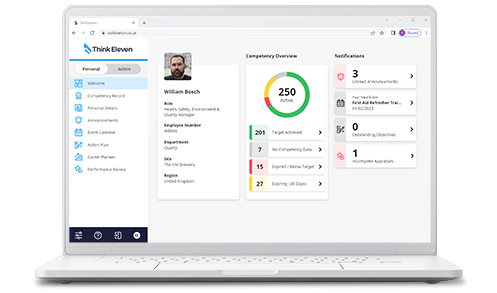For modern organisations, whether they are large multinational or an SME, it is crucial to ensure that employees and subcontractors are fully trained and compliant to adhere to laws and regulation, work safely, and to stay one step ahead of the competition.
A well-structured training matrix serves as a foundational tool in this process, helping organisations assess and enhance employee training and skills systematically. While many rely on a simple training or skills matrix template or an Excel spreadsheet, these traditional methods often fall short. This is usually because the methods are disjointed, require a lot of maintenance to maintain accuracy, decentralised, and lack the depth of information to run high-quality insightful reports. Let's explore how a dedicated competency management system offers a superior alternative, ensuring accuracy, ease, and comprehensive reporting and functionality.
Understanding Competency and Skills Matrices
A skills matrix—also known as a skill set matrix or competency matrix—is an essential tool that maps out the skills, knowledge, and behaviours required by an individual to perform their job effectively. Traditionally managed through a skills matrix template in Excel, these matrices help HR managers and team leaders visualise the competencies present within their teams and identify gaps that need addressing.
However, the static nature of typical skills matrix templates or training matrix templates can limit their effectiveness. They often require manual updates and can become outdated quickly, leading to errors and misinformed decisions.
Excel Skills Matrix vs. a Competency Management System
Switching from a traditional Excel skills matrix or a basic training matrix template to a robust competency management system can transform an organisation’s approach to managing workforce capabilities.
Advantages of a Competency Management System:
Speed and Efficiency: Automatically generates and updates skills matrices and training matrices, saving valuable time and reducing the likelihood of human error.
Comprehensive Analysis: Offers deeper insights into workforce capabilities, going beyond basic skills matrix examples or training matrix samples to provide dynamic solutions tailored to real-time needs.
Error Reduction: Minimises the inaccuracies often found with manually maintained skills matrix templates Excel or training matrix template Excel files.
For instance, while a skills matrix example in Excel provides a snapshot, a competency management system continuously adapts to new data, ensuring that leaders have accurate and up-to-date information for making strategic decisions.
Integrating Training and Skills Development
A dynamic system not only tracks current employee skills using a skill will matrix or skill and will matrix approach but also aligns this with ongoing training initiatives. This seamless integration ensures that training programs are directly enhancing the skills that matter most to your organisation.
Examples of usage:
- A tech company uses the system to transition from a rudimentary training matrix for employees to a sophisticated model that tracks progress against industry-standard competencies.
- A manufacturing firm implemented a system to refine their management of training, which significantly improved operational efficiency by aligning skills development with actual production needs.
Best Practices for Implementing Competency and Training Matrices
To make the most of integrating a competency management system into your organisation requires a strategic approach. Here are some essential best practices:
- Continuous Improvement: Regular updates to the competency framework is crucial. As job roles evolve and new technologies emerge, the matrix of competencies must adapt to reflect these changes accurately. This ensures that the system remains relevant and effective.
- Targeted Training Programs: Develop specialised training programs for HR personnel and line managers that focuses on the strategic interpretation and application of data from the competency management system. This training should emphasise how to utilise the skills matrix and training matrix to identify skills gaps to tailor and focus employee development programs accordingly.
- Engagement and Communication: Foster a culture of continuous learning and transparency by regularly communicating the benefits and updates of the competency management system to all stakeholders. Highlight how this proactive approach to skill and competency management benefits individual career paths and the organisation’s goals.
- Integration with Performance Management: With SkillStation, the optional Performance Appraisal module help managers to support employees with developing and measuring performance and career development plans. This alignment helps personalise employee growth trajectories and reinforces the practical value of maintaining workforce data.
Common Pitfalls in Competency Management and How to Avoid Them
Implementing a new system can come with its set of challenges. Here are some common pitfalls and strategies to avoid them:
- Resistance to New Technologies: Resistance often stems from a lack of understanding or fear of increased workload. Mitigate this by providing hands-on workshops and demonstrations that showcase the system's ease of use and how it reduces workload by automating routine tasks.
- Inconsistent Data Entry: Ensure the integrity of your competency data by setting strict guidelines for data entry and maintenance. Regular audits of the matrix data can help catch inconsistencies or errors early.
- Lack of Alignment with Business Goals: Ensure that the setup of your competency management system aligns directly with your business’s strategic objectives. Engage senior management in the implementation process to align the system's capabilities with long-term business goals.
- Failing to Leverage Data for Strategic Decisions: Equip leadership with the knowledge to use the system for strategic decision-making. Highlight successful case studies within your organisation or similar industries where competency management systems have driven significant business outcomes.
Closing Thoughts...
Using a comprehensive competency management system instead of relying on outdated skills matrix template Excel files or training matrix template Excel sheets is not just about keeping up with technology—it's about leveraging it to gain a competitive edge.
Ready to revolutionise how your organisation manages competencies? Contact us today for a demo of SkillStation and see how we can tailor our solution to meet your specific needs. Transform your competency management from static to strategic with SkillStation.


